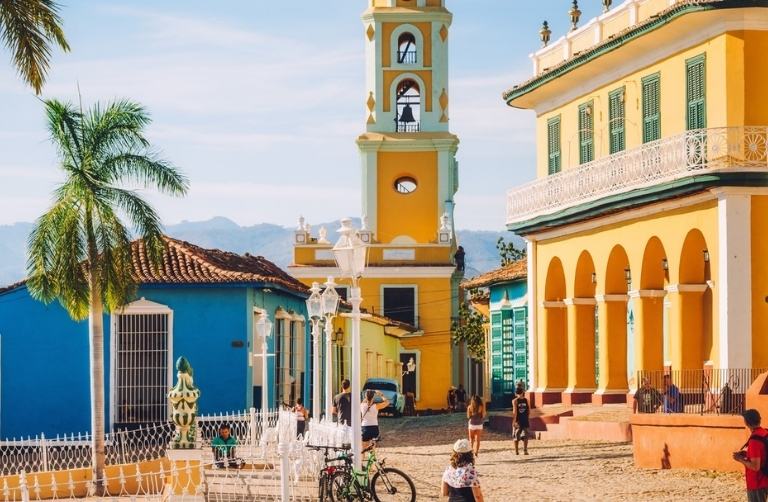From avoiding tropical storms to the challenges of moving between destinations, a trip to the Caribbean can take some planning. Check out these useful tips from an expert on the region.
 Photo © Getty Images / Westend61
Photo © Getty Images / Westend61
Climate and weather
From Jamaica’s steamy mangrove swamps to the occasionally snowy top of Pico Duarte in the Dominican Republic, the Caribbean’s weather is as diverse as its natural environment.
The entire region benefits from its proximity to the equator – from about 1,700mi (2,735km) in the northern Caribbean to around 621mi (1,000km) on Panama’s Caribbean coast – leading to warm temperatures usually between 25-33°C (77-90°F). That being said, there’s marked variation in climate across the thousands of islands and the surrounding mainland nations.
Exotic wildlife inhabits the rainforests and reefs that abound throughout the Caribbean, which is considered a biodiversity hotspot. Finding activities that help you explore the environment is easy, and can provide valuable information regarding local conservation efforts and projects aimed at safeguarding the region’s natural capital for future generations.
Many islands and mainland nations, such as Puerto Rico, in the eastern Caribbean, and Costa Rica and Belize, in Central America, feature warm, humid tropical weather. Meanwhile, the southern Caribbean islands of Aruba, Bonaire, and Curaçao tend to have a drier tropical climate, evident in their savannah-like landscapes and broadleaf forest. More temperate climates can be found on the elevated terrain of mountainous islands such as Dominican Republic, Haiti, or Jamaica.

Best time to visit
The Caribbean experiences a period of dry, warm weather from December to April, and a wet season, which stretches from May to November, with the highest risk of hurricanes and tropical storms occurring between June and November. Transport options, including flight or ferry schedules, can be affected by inclement weather, so it’s important to stay updated and trust the decisions made by local operators.
Caution is always warranted when booking holidays during the wet season, but remember that the region is vast, and that a severe weather event occurring somewhere in the area is not always likely to affect your own destination. Responsible travelers should monitor reports from the Global Disaster and Coordination System (GDACS) and other official sources. But refrain from instantly cancelling your vacations when a hurricane hits the news, and instead contact your hotels and listen to local authorities and advice.

Getting around the Caribbean
While all-inclusive package holidays are ubiquitous in the Caribbean, travelers who want to explore their own way will get to experience the region from a totally different perspective. Backpackers are still infrequent, but for the adventurous traveler with an open mind, it can be a highly rewarding opportunity.
Flights
Many flights to the region transit through Miami/Fort Lauderdale or Panama, but there are direct flights from various US, Canadian, and European cities to some islands. Traveling between islands can be surprisingly difficult and expensive, meaning any multi-island trip requires advanced planning. The regional carrier LIAT links some destinations in the Eastern Caribbean, but you’ll often hear the joke that the acronym stands for “Leave Island Any Time”, serving as a playful warning to travelers (note: as of November 2020 the airline has been operating at a reduced capacity).
Island transport
Transport within the islands tends to be relatively easy, but can sometimes be expensive. Taxis are usually a safe option but require the same common sense that you would employ at home. Local buses on many islands provide an affordable alternative, but you may have to ask around to work out the schedules and routes. In Jamaica, the Knutsford Express provides a reliable, comfortable option with air conditioning and Wi-Fi, and serves most major towns on the island.
Ferries
Despite its beautiful waters and the short distances between islands, the Caribbean lacks an extensive ferry network. Fort Lauderdale, Florida to Freeport, Grand Bahama is the only regular ferry link between the region and the United States, and services departing from South or Central America are available from only a handful of ports to nearby islands.
Domestic ferry links are common within countries to their smaller islands, such as from Trinidad to Tobago, Grenada to Carriacou, St. Vincent to the Grenadines, and within the Bahamas archipelago. One of the best options for an international island trip is with the L'Express des Îles ferries running frequently to connect the islands of Dominica, Guadeloupe, Martinique, and St. Lucia.
Related articles
Simple and flexible travel insurance
You can buy at home or while traveling, and claim online from anywhere in the world. With 150+ adventure activities covered and 24/7 emergency assistance.
Get a quote

No Comments